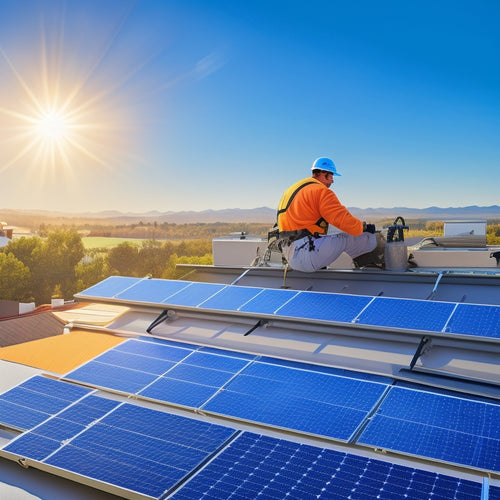
What Is the Cost of Solar Panels With Battery Storage for Your Home
Share
You can expect to pay between $25,000 and $80,000 or more for a solar panel system with battery storage for your home, depending on the system size, battery type, and installation complexity. The cost of solar panels alone ranges from $15,000 to $30,000, while battery storage systems can add another $10,000 to over $50,000. Factors like system configuration, efficiency, and technology advancements also impact the overall cost. To get a better understanding of the costs involved and how to make the most of your investment, it's crucial to investigate the subtleties of each component and their impact on your energy goals.
Key Takeaways
- The average cost of solar panel systems with battery storage ranges from $15,000 to $30,000, depending on system size and battery type.
- Residential battery system prices range from $10,000 to over $50,000, with lithium-ion batteries offering longer lifespans and higher energy efficiency.
- System sizing and pricing depend on energy usage and desired grid independence, with typical battery storage ranging from 5-15 kWh for residential systems.
- Installation and labor costs contribute significantly to total expenses, ranging from $2,000 to $5,000, with additional costs for permits, inspections, and maintenance.
- Federal tax credits and financing options can significantly reduce upfront costs, making solar panels with battery storage a more affordable option for homeowners.
Understanding Solar Panel Costs
How much do solar panels actually cost? The answer depends on several factors, including the system size, quality, and installation company.
On average, a solar panel system can cost between $15,000 and $30,000. However, with solar incentives and financing options, the upfront cost can be greatly reduced.
Investing in solar panels provides energy independence, environmental benefits, and contributes to grid stability. Thanks to technological advancements, solar panels are becoming more efficient and affordable.
You'll enjoy long-term savings on utility rates, increased home value, and minimal maintenance requirements. While the initial investment may seem steep, solar panels can pay for themselves over time.
Battery Storage System Prices
You'll need to evaluate the type of battery you want, as different options like lithium-ion, lead-acid, and saltwater batteries come with varying price tags.
The size of your system also affects the cost, as you'll need to determine how much energy storage you require to meet your power needs.
Additionally, installation and labor costs will add to the overall expense, so it's crucial to factor these in when calculating the total cost of your battery storage system.
Battery Types and Costs
Several options exist for homeowners and businesses seeking to integrate battery storage into their solar panel systems. When considering battery types and costs, you'll likely come across lithium-ion and lead-acid batteries.
Lithium-ion batteries offer several advantages, including a longer lifespan, higher energy efficiency, and lower maintenance requirements. They also have a higher number of charging cycles, making them a more reliable option. However, they're more expensive upfront.
Lead-acid batteries, on the other hand, have some disadvantages, such as a shorter lifespan and lower energy efficiency. They are, however, more cost-effective initially.
When evaluating battery types, you should also consider installation complexity, environmental impact, and performance metrics.
Lithium-ion batteries have a more complex installation process, but they've a lower environmental impact due to their recyclable materials.
Lead-acid batteries have a simpler installation process, but their environmental impact is higher due to the lead content.
Safety considerations are also essential, as lithium-ion batteries have built-in safety features, while lead-acid batteries require additional safety measures.
System Sizing and Pricing
As you've weighed the pros and cons of lithium-ion and lead-acid batteries, it's time to determine the ideal system size and pricing for your battery storage needs.
The size of your battery storage system depends on your energy usage, solar energy efficiency, and desired level of grid independence. A typical residential battery storage system ranges from 5-15 kilowatt-hours (kWh), with prices varying accordingly.
For a small system (5-10 kWh), you can expect to pay between $10,000 and $20,000. A mid-sized system (10-15 kWh) will cost between $20,000 and $30,000. Larger systems (15 kWh and above) can range from $30,000 to $50,000 or more.
Keep in mind that these prices are for the battery storage system alone and don't include the cost of solar panels or installation.
When determining the ideal system size, consider your daily energy usage, the number of days you want to be grid-independent, and the amount of solar energy you can generate.
A well-sized system will guarantee you have enough power during outages and maximize your solar energy efficiency.
Installation and Labor Costs
Installing a battery storage system requires careful planning and execution, and labor costs can add a significant chunk to your overall expenses. As you consider financing options for your solar panel system with battery storage, it's crucial to factor in the installation and labor costs. These costs can vary depending on the complexity of the project, project timelines, and the need for installation permits.
| Labor Cost Component | Average Cost Range | Description |
|---|---|---|
| Installation Labor | $2,000 - $5,000 | Installation of battery storage system, including grid connection and electrical work |
| Permits and Inspections | $500 - $2,000 | Obtaining necessary permits and passing inspections to guarantee compliance with local regulations |
| Maintenance Schedules | $500 - $1,000 | Setting up regular maintenance schedules to promote ideal system performance |
| System Commissioning | $1,000 - $2,000 | Testing and commissioning the system to verify it's working as expected |
| Project Management | $1,000 - $3,000 | Overseeing the entire project, including coordination with local authorities and utilities |
Total System Cost Breakdown
Your total system cost breakdown for solar panels with battery storage includes multiple components, each with its own price tag. These components include the solar panels themselves, the battery storage system, inverters, mounting and tracking systems, and electrical infrastructure.
You'll also need to take into account the cost of grid connection, which allows you to sell excess energy back to the grid and offset your energy bills.
When evaluating your total system cost, it's crucial to take into account the long-term savings and benefits. With solar financing options, you can reduce your upfront costs and start seeing a return on your investment soon.
By going solar, you'll not only reduce your environmental impact but also achieve energy independence. Additionally, advancements in technology have improved the efficiency and reliability of solar panels, reducing maintenance requirements and increasing their lifespan.
As you weigh the costs, remember that solar panels with battery storage can provide a significant reduction in your energy bills, leading to long-term savings and a strong return on your investment.
Factors Affecting Overall Cost
System configuration plays a significant role in determining the overall cost of solar panels with battery storage. You'll need to take into account factors such as system efficiency, technology advancements, and utility rates.
For instance, a more efficient system can lead to long-term savings and energy independence, but it may come at a higher upfront cost. Financing options can help spread the cost over time, making it more manageable for you.
Additionally, maintenance considerations come into play. A well-maintained system can last longer and perform better, but it requires regular upkeep.
On the other hand, environmental benefits and energy independence can bring a sense of satisfaction and belonging to your community.
You'll also need to take into account the cost of battery storage, which can vary depending on the type and quality of the batteries.
Average Cost Per Watt
When considering the average cost per watt of a solar panel system with battery storage, you'll find that system size plays a significant role.
The type of battery you choose also impacts the cost, with different chemistries and configurations affecting the overall price.
Additionally, installation factors, such as labor and hardware costs, will influence the final cost per watt of your system.
System Size Matters
Taking into account the intricacies of solar panel systems, it's essential to understand that the size of your system has a direct impact on the overall cost. The larger the system, the more solar capacity you'll have, which means greater energy independence and environmental benefits. However, this increased capacity comes at a higher upfront cost.
When determining the size of your system, you'll want to contemplate your energy usage and goals. Are you looking for long-term savings or a backup power source during grid outages? A larger system may be necessary to achieve these objectives. On the other hand, a smaller system may be more suitable if you're looking to supplement your energy usage.
System efficiency, financing options, and installation timelines also play a role in determining the size of your system. Additionally, maintenance frequency and technology advancements can impact the system's performance over time.
Battery Type Impacts
Your battery type plays a significant role in determining the overall cost of your solar panel system with battery storage.
You'll want to evaluate the pros and cons of different battery types to make an informed decision. Lithium-ion batteries, for instance, offer several advantages. They're highly energy-efficient, with a long lifespan of up to 15 years, and can handle a high number of charging cycles. Additionally, they've a lower environmental impact compared to lead acid batteries.
However, lithium-ion batteries come at a higher upfront cost. Lead acid batteries, on the other hand, are more affordable but have shorter lifespans, require more maintenance, and are less efficient.
When comparing costs, assess the performance metrics of each battery type, such as depth of discharge, round-trip efficiency, and warranty duration.
Keep in mind that installation options and maintenance requirements also vary between battery types. By understanding these factors, you can make a cost-effective decision that meets your energy needs and budget.
Installation Affects Price
The installation process can greatly influence the overall cost of your solar panel system with battery storage, and one key factor to evaluate is the average cost per watt.
This figure varies depending on the installation challenges you face, such as complex roof layouts or shading issues. A longer installation timeline can also drive up costs, so it's crucial to choose a contractor who can complete the job efficiently.
Additionally, installation permits, local regulations, and inspections can add to the overall expense. Your installation location also plays a significant role, as installations in remote areas may require more materials and labor.
The type and quality of installation materials, such as mounting hardware and wiring, can also impact the average cost per watt.
When selecting an installation contractor, look for those who offer extensive warranties and adhere to local regulations. By carefully evaluating these factors, you can get a more accurate estimate of the cost of your solar panel system with battery storage.
Installation and Maintenance Fees
About 10% to 20% of your total solar panel system cost goes towards installation and maintenance fees. This significant portion of your investment covers the knowledge and labor required to guarantee your solar panel system with battery storage is installed correctly and efficiently.
You'll want to take into account factors like installation timeframe, contractor selection, and local regulations to guarantee a smooth process. Proper installation is vital for energy efficiency and ideal performance.
Performance monitoring systems can help identify potential issues, and maintenance tips can extend the lifespan of your system. Additionally, warranty coverage provides peace of mind in case any components fail or require replacement.
When exploring financing options, factor in these installation and maintenance fees to guarantee you're getting the best deal. Remember, grid connection requirements may also impact your overall cost.
Incentives and Rebate Opportunities
You're likely wondering how to maximize your savings on your solar panel system with battery storage.
Fortunately, there are various incentives and rebate opportunities available to help offset the upfront cost. At the federal level, you can claim a tax credit of up to 26% of the total system cost, including the battery storage.
Additionally, many states offer rebates and incentives, such as California's Self-Generation Incentive Program, which provides a rebate of $0.36 per watt for energy storage systems.
You may also be eligible for financing options, utility programs, and solar grants, which can help reduce the financial burden.
Moreover, installing a solar panel system with battery storage can also provide long-term energy efficiency and environmental benefits, leading to lower electricity bills and a reduced carbon footprint.
Frequently Asked Questions
Can I Install Solar Panels on a Rented Property?
You'll need to review your rental agreements and obtain your landlord's permissions before installing solar panels on a rented property, as modifications to the property typically require their consent and may be subject to specific terms.
Do Solar Panels Work During Power Outages?
You're probably wondering, do solar panels work during power outages? Curiously, 70% of US homeowners experience power outages each year. With solar panels and battery storage options, you can enjoy up to 95% solar panel efficiency, ensuring you stay powered on, even when the grid goes down.
How Long Does a Solar Panel System Last?
You'll be pleased to know that a well-maintained solar panel system can last around 25-30 years, with some components lasting up to 40 years; however, regular maintenance and occasional replacements will be necessary to minimize maintenance costs and guarantee peak system lifespan.
Are Used or Refurbished Solar Panels a Viable Option?
You're considering used or refurbished solar panels, which can be a cost-effective option, but you'll need to inspect them carefully for wear and tear, ensuring they meet your energy needs and local building codes.
Can I Sell Excess Energy Back to the Grid?
You're likely aware that 77% of Americans support renewable energy; now, you're wondering if you can sell excess energy back to the grid. Through net metering benefits and energy buyback programs, you can, and you'll even receive credits on your utility bill for the excess energy produced.
Conclusion
As you utilize the power of the sun to fuel your home, the cost of solar panels with battery storage becomes a vital consideration. Like a puzzle, the total system cost comes together with each piece: panel prices, battery storage system costs, installation fees, and incentives. With an average cost per watt of around $2.50, the overall expense can be a significant investment. However, as the sun rises on a cleaner energy future, the long-term savings and benefits will illuminate your path forward.
Related Posts
-

10 Essential Bike Lane Safety Features to Consider
You're designing a bike lane with safety in mind, and that's essential. The National Highway Traffic Safety Administr...
-

Top 10 DIY Conversion Kit Reviews and Tips
You're taking the first step towards electrifying your ride, and with the right DIY conversion kit, you'll be cruisin...
-

3 Essential Steps for Solar Electricity Installation
To guarantee a successful solar electricity installation, you'll need to follow three essential steps. First, assess ...


